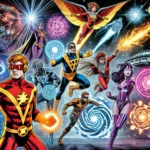Movies have a unique power to transport us into different worlds, evoke deep emotions, and tell compelling stories. A key element that plays a significant role in creating these immersive experiences is the movie soundtrack. Music in film is more than just background noise; it is a vital tool that filmmakers use to shape the viewer’s emotional journey. From creating tension in a thriller to adding a sense of nostalgia in a romantic drama, soundtracks are a fundamental aspect of cinema. In this article, we explore how music shapes emotion in film and the artistry behind creating a memorable movie soundtrack.
The Role of Music in Film
Music has been an integral part of storytelling since the earliest days of cinema. It sets the tone, enhances the atmosphere, and directly influences how the audience feels about the scenes unfolding before them. A well-crafted soundtrack can make a scene unforgettable, heightening emotional responses, whether it’s joy, sadness, fear, or excitement. For example, the absence of music in a suspenseful scene can create an eerie silence that heightens tension, while a swelling orchestra during a climactic moment can amplify a sense of triumph or sorrow.
The role of music goes beyond merely supporting the narrative; it often acts as a character in itself. Iconic scores, like John Williams’ compositions for “Star Wars” or Ennio Morricone’s work in “The Good, the Bad and the Ugly,” are not just memorable for their melodies but for how they define the films they accompany. These soundtracks add a layer of emotional depth, making the viewing experience richer and more engaging.
Key Elements of a Successful Soundtrack
A successful movie soundtrack is composed of several key elements that work together to evoke the desired emotional response from the audience:
- Melody: The melody is the most recognizable part of a soundtrack, often becoming synonymous with the film itself. It is the tune that sticks in the viewer’s mind long after the movie has ended, like the iconic “Hedwig’s Theme” from the “Harry Potter” series.
- Rhythm and Tempo: The rhythm and tempo of a piece can influence the pacing of a scene. Fast-paced music can create a sense of urgency and excitement, while slower tempos can evoke feelings of contemplation or sadness.
- Instrumentation and Timbre: The choice of instruments and their timbral qualities play a significant role in setting the mood. For example, the use of strings can create a lush, emotive sound, while percussion can add intensity or drive.
- Silence and Sound Design: Sometimes, the absence of music can be just as powerful as its presence. Strategic use of silence, coupled with sound design, can create a sense of unease or anticipation.
Each of these elements must be carefully considered by composers and sound designers to align with the director’s vision and the narrative’s emotional arc.
Famous Examples of Effective Soundtracks
Several films have set a benchmark in using soundtracks effectively to enhance storytelling:
- “Jaws” (1975) – John Williams: The minimalist two-note motif is perhaps the most famous example of music creating a psychological response. It evokes a sense of imminent danger, becoming synonymous with the unseen threat of the shark.
- “Inception” (2010) – Hans Zimmer: Zimmer’s soundtrack uses a mix of orchestral and electronic elements to complement the film’s complex narrative structure. The use of the Édith Piaf song “Non, Je Ne Regrette Rien,” slowed down and integrated into the score, plays a crucial role in both the story and the film’s atmosphere.
- “The Lord of the Rings” Trilogy (2001-2003) – Howard Shore: Shore’s work on this epic trilogy is an excellent example of using leitmotifs—recurring musical themes associated with particular characters or locations. Each motif enhances the audience’s connection to the storyline and the characters, making the journey feel even more epic.
- “The Lion King” (1994) – Hans Zimmer and Elton John: Combining African rhythms and traditional Western music, this soundtrack not only enhances the film’s vibrant setting but also underscores its emotional themes of loss, identity, and redemption.
The Process of Creating a Movie Soundtrack
Creating a movie soundtrack is a collaborative and multi-step process that involves close cooperation between the director, composer, and sound designers.
- Understanding the Vision: The composer meets with the director to understand the vision for the film and the role music will play. This stage involves discussions about mood, themes, and specific scenes where music will be pivotal.
- Composing and Scoring: The composer writes music that aligns with the director’s vision, often creating multiple themes or motifs to represent different characters or emotions. The composition process can take several months, depending on the film’s complexity.
- Recording: Once the score is composed, it is recorded by musicians, often with an orchestra. This stage is crucial, as the live performance brings the music to life and adds a dynamic quality to the soundtrack.
- Editing and Mixing: The final step is the editing and mixing of the music with the film’s dialogue and sound effects. The soundtrack is carefully synced with the visuals to ensure it complements the narrative and enhances the emotional impact.
Conclusion
The art of the movie soundtrack is a complex and nuanced process that significantly impacts how audiences perceive and experience a film. By carefully crafting music that aligns with the narrative’s emotional beats, filmmakers can create unforgettable cinematic moments that resonate with viewers long after the credits roll. As technology evolves and new musical trends emerge, the role of the soundtrack in shaping emotions will continue to be a vital element of the filmmaking process.


